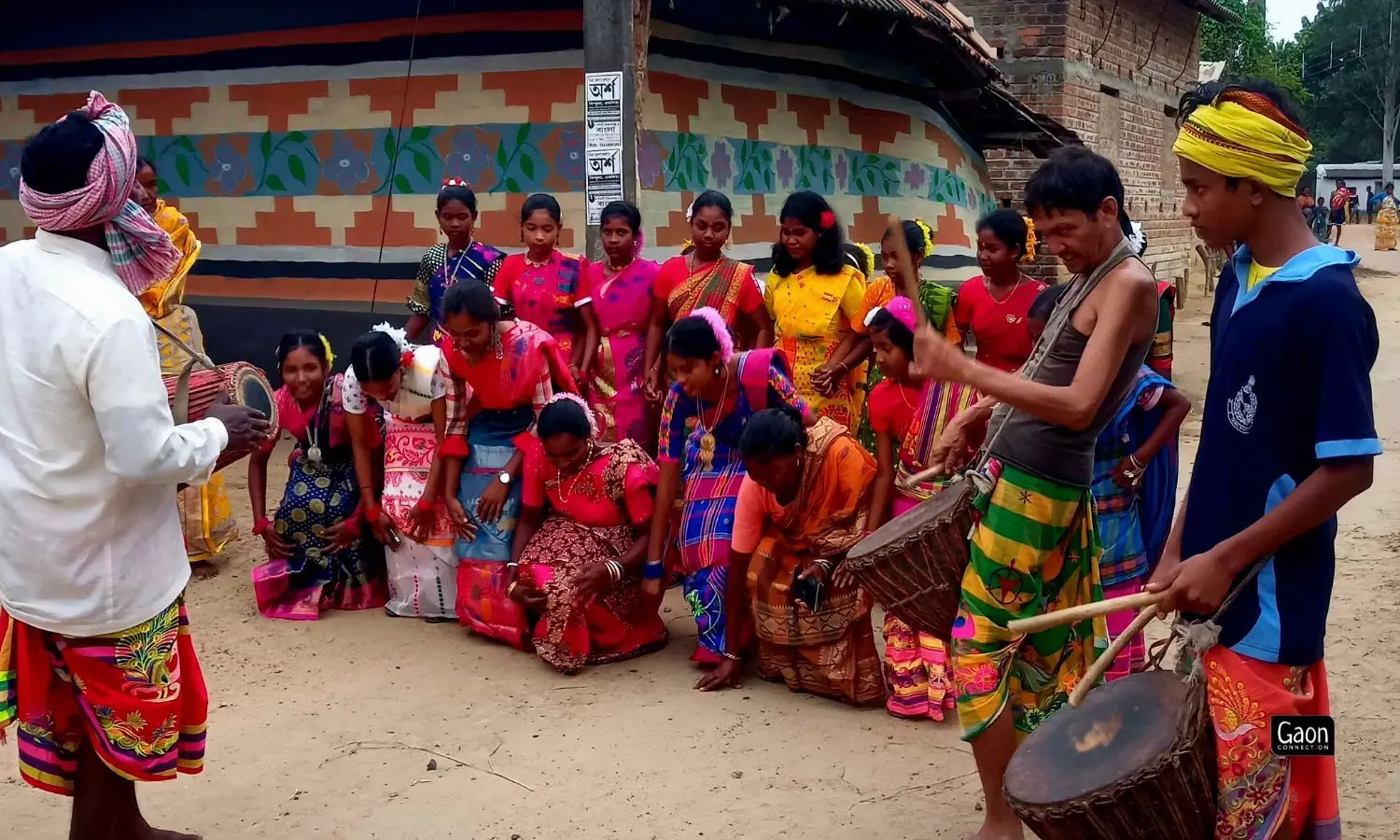Bandhna Parob, the Bonding Festival of Tribal Communities in Jangalmahal
In the Jangalmahal area of West Bengal, drums, songs and festivities carry on for two weeks as villagers send up prayers of gratitude for a bountiful harvest and the well-being of their cattle.
 Madhu Sudan Chatterjee 25 Nov 2023 10:25 AM GMT
Madhu Sudan Chatterjee 25 Nov 2023 10:25 AM GMT

Bandhna Parob (Bonding Festival) started from November 13 this year, a day after Diwali, and will conclude on the Full Moon night on November 27. It is celebrated by the Munda, Bhumij, Kora, Sabar communities. All Photos by Madhu Sudan Chatterjee.
Jangalmahal (Bankura), West Bengal
Diwali celebrations and Chhath festivities are over but in the forest villages of Jangalmahal in West Bengal, tribal communities continue to celebrate their traditional festival, that starts on Diwali and concludes after 14 days.
Bandhna Parob (Bonding Festival) started from November 13 this year, a day after Diwali, and will conclude on the Full Moon night on November 27. It is celebrated by the Munda, Bhumij, Kora, Sabar communities.
Bandhna Parob is also known as Garoya Parob festival by the Kurmi tribal community, and it coincides with the Sohrai Porab of the Santhal tribe.
Drum beats from the dhamsda and madal, traditional musical instruments, fill the forests and glades of the Jangalmahal in Bankura district, about 165 kilometres from the state capital Kolkata.
Bandhna Parob is also known as Garoya Parob festival by the Kurmi tribal community, and it coincides with the Sohrai Porab of the Santhal tribe.
The tribal communities in this area are spread out across Bankura, Purulia, Jhargram, and Paschim Medinipur districts and they all celebrate the festival, which is marked by gratitude to Mother Nature for a bountiful harvest and prayers for the well-being of their cattle.
The festivities mark the paddy harvesting season. It begins with prayers of thanksgiving for a bountiful crop sent up. The livestock are a big part of the celebrations too as without them there can be no agriculture, the tribal communities believe.
Also Read: A Day After Diwali, Santhal Tribe Celebrates Sohrai Porab to Honour Its Cattle
“It is a festival of harmony. Humans need food to survive. People celebrate this festival as an expression of joy and gratitude for the paddy harvest,” Madhu Sudan Mahato, a farmer from Ranibandh village in Bankura district, told Gaon Connection.
One of the highlights of the festival, especially amongst the Kurmi, Bhumij, Shabar, Kora and Lodha communities is the celebration of cattle with song and dance.
Homes are decorated with alpona or designs made of rice flour, and the Ahira gaan or songs of Ahira sung in the Kurmali language, resonate across villages. They sing of kurmi communities travelling miles to find out the welfare of the cows, and bringing with them offerings of the nutritious grass called molta.
"We acknowledge the hard work the cattle put in the year around and this is the time we pray for their continued wellbeing as without them humankind will have no food,” Taroni Mahato from Ranibandh, who sings the Ahira songs, told Gaon Connection.
One of the highlights of the festival, especially amongst the Kurmi, Bhumij, Shabar, Kora and Lodha communities is the celebration of cattle with song and dance.
“We wear new clothes and worship the cows in their cowshed with Saluk flowers and rice cakes fried in ghee. Ploughs, spades, and other tools used in agriculture are cleaned and worshipped too,” described Porna Mahato from Sindurpur village.
“The horns of the cattle are cleaned anointed with mustard oil and vermillion. Garlands made of paddy are tied across their foreheads. They are considered the symbols of wealth and fertility,” she added and said that after the puja the prasad was distributed amongst family members.
“Adivasis are nature worshippers. So images of trees, birds and animals are painted on the walls, with the diluted rice flour,” said Mohan Hembram, a resident of Barikul village in Bankura.
Also Read: Know why Uttarakhand’s Igas Festival is Celebrated 11 Days after Diwali
Amongst the Santhal community, the Sohrai festival goes on for four days. It starts a day after Diwali.
On the first day, the village priest, called Naike, starts the proceedings at the Jaherthan (worship place). Chicks are sacrificed and then cooked and shared amongst the people, after which the music and dance begins.
On the second day, goats are slaughtered and added to rice and cooked into the jeldaga or meat rice, which is again shared in a feast.
It is a festival that celebrates the harmony between humans, animals, and nature.
The third day is the day of the cow where the animal is tied to a strong pole and made to smell the skin of a dead cow. This ritual is called gorukhuta. Agitated, the cow begins to circle the pole it is tied to and the drums start beating loudly accompanied by Ahira songs. The music continues long into the night.
These festivities also include the ritual of inviting home sons-in-law who are then fed and given new clothes. This practice is called jamai bandhna.
Bandna festival is not only about joy and gratitude but also a way of keeping the rich and ancient traditions of tribal communities alive. It is a festival that celebrates the harmony between humans, animals, and nature. .
#bandhnaparob #tribals #jangalmahal
More Stories




